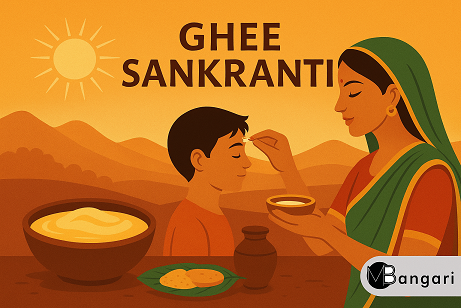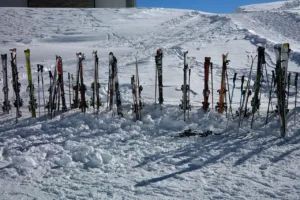By – Mohit Bangari

Explore Himalaya With Me!!

Ghee Sankranti is a beloved folk festival of Uttarakhand. People also call it Olgia, Ghu Sankranti, Ghu Tyar, or Ghiyu Sankrant. It comes every year in the month of Bhado, on the very first day. In 2025, it falls on 17 August. The day celebrates harvest, cattle, and the bond between families and community.
At heart, Ghee Sankranti is simple. We thank nature for crops, milk, and butter. We honour cows and buffaloes. We share food with family and neighbours. We keep old bonds alive through gifts and visits. The name itself shows the importance of ghee. On this day, ghee becomes both prasad and food.
You will hear different names in different parts. In Kumaon, many people say Olgia. In villages, elders still say Ghu Tyar or Ghiyu Sankrant. The festival is common in both Kumaon and Garhwal, but customs can change from valley to valley.
The festival arrives at the start of Bhado. Monsoon has brought green fields by now. Maize, pulses, and vegetables look healthy. Milk supply also improves after the rains. So the timing suits a thanksgiving mood. People feel hopeful. Families stock ghee and butter. They cook special rotis and local vegetables.
People wake up early. They clean the aangan. Women light the diya. Many families first offer ghee in a small bowl at the family shrine. Then they taste a little, and later serve it with meals. Mothers often apply a bit of fresh butter or ghee on children’s heads. They bless them for a long, healthy life. In many homes, fresh vegetables and grains from the fields are offered first to the deity kept at home.
Food is the highlight. Bedu roti is traditional. It is a stuffed bread. The filling usually has urad dal. The roti tastes best with a generous spoon of homemade ghee or white butter. Many homes also cook simple local vegetables. Colocasia leaves and stems are common in some belts. Maize items also come on the plate. Overall, the thali is earthy, fresh, and made from local produce.
Olag or Olagia is a beautiful part of Ghee Sankranti. It is not just about gifting. It shows respect and togetherness. Traditionally, farmers would carry the season’s first produce to elders, landlords, or patrons. Grains, ghee, curd, and vegetables went as Olag. In some families, sons-in-law or nephews brought small gifts for in-laws and maternal uncles. In return, elders blessed them and sometimes gave money, grain, or cloth. This exchange created warmth and trust in the village.
Old stories from the hills say that village artisans also visited patrons on this day. Blacksmiths would bring a new sickle or a tool. Carpenters would bring small wooden toys for children. Tailors would stitch caps or a small purse. Priests received food and small offerings. This cycle of giving kept local skills alive. It reminded every family that all hands matter in a mountain village.
By afternoon, the village looks festive. Children run around with rotis and a dollop of ghee. Elders sit together and talk about crops, rain, and fodder. Some places have simple folk singing and playful teasing among relatives. People visit each other’s homes with a small thali of food. There is no show-off. The tone stays homely and warm.
Ghee stands for strength and purity in the hills. It gives energy in the cold and rain. It also connects the kitchen to the cowshed. When a family uses ghee as prasad first, they honour the animal that feeds them. They also honour the work behind it—grazing, milking, churning, and storing. In short, ghee ties farm, forest, and family into one circle.
With time, Olag to landlords or patrons has reduced in many places. Village crafts have also shrunk. Yet, the core of the festival remains alive, especially in rural belts. People still cook bedu roti. They still use ghee with pride. They still visit relatives. In towns, families adapt the ritual to city life. They may buy ghee from the market. They may keep the puja small. But the feeling of gratitude stays.
Uttarakhand has many small but meaningful festivals where nature, food, and culture come together. Just like Butter Festival at Dayara Bugyal, which I have already written about here: Butter Festival – 2025 at Dayara Bugyal, a Celebration of Nature, Culture & Butter, Ghee Sankranti also celebrates dairy, farming, and togetherness. Both festivals show how deep the bond between people, cattle, and land runs in the Himalaya.
If you visit Uttarakhand around mid-August, try to stay in a homestay in a village. Ask your host politely about local customs. Offer to help with small tasks in the kitchen. Taste bedu roti, but avoid food waste. Dress modestly. Always ask before taking photos inside the courtyard. If you wish to carry a token gift, take something simple and useful—jaggery, seasonal fruits, or a packet of tea. Travel with respect, not in a hurry.
Buy ghee from local dairies or women’s groups. Carry your own bottle for water. Avoid plastic plates and spoons. Keep sound low. Remember, this is a family festival, not a fair. Your gentle behaviour will be your best Olag to the hosts.
Do start the day early and keep things clean.
Do taste ghee as prasad before meals.
Do visit elders if you are in your native village.
Do keep portions small; take a second serving if needed.
Don’t waste ghee or food.
Don’t click photos during puja without permission.
Don’t compare dishes. Every home has its own style.
Date: 17 August 2025 (first day of Bhado).
Names: Ghee Sankranti, Olgia, Ghu Tyar, Ghu Sankranti, Ghiyu Sankrant.
Focus: gratitude for crops, cattle, milk, and community bonds.
Core foods: bedu roti with ghee/white butter; simple local vegetables.
Custom: Olag gift-giving between families, elders, and artisans.
Is Ghee Sankranti only a Kumaon festival?
No. It is known across Uttarakhand. However, Kumaon uses the name Olgia more commonly.
Is there any special recipe that is a must?
Yes. Bedu roti with ghee is classic. Many homes add urad dal in the stuffing.
Do people still give Olag today?
Yes, but in smaller, modern ways. Some families exchange sweets, fruits, or small cash. The spirit is the same.
How is it different from Makar Sankranti?
Makar Sankranti comes in January with khichdi or ghughuti in the hills. Ghee Sankranti comes in Bhado and centres the meal around ghee and fresh seasonal produce.
Can travellers join the rituals?
With permission, yes. Keep it simple. Follow the family’s lead. Offer help, not advice.
Ghee Sankranti is soft and homely. It does not need big pandals or loudspeakers. It needs family, food, and good feeling. It tells us to value milk, grain, and the hands that grow them. In the Himalaya, that lesson is gold.
By – Mohit Bangari
You can also explore more on Himalayan treks like Darma Valley, Adi Kailash, and others on my website mohitbangari.com, where I share full guides, routes, permit tips and cultural info.
Do you know about Ramman festival of Salud-Dungra village? It’s one of the intangible world cultural heritage of India in UNESCO. You can read a detailed article on this topic here.


Explore Himalaya With Me!!


Explore the beauty and cultures of the Himalayas, from Jammu and Kashmir to Arunachal Pradesh, Tibet and Nepal. My blog shares stories, pictures, and fun articles about this amazing region. Come along on a journey where each mountain has a tale and every valley hides a treasure. Join me as I discover the magic of the mountains together.
Welcome to my Himalayan Adventure!